Abstract
Diabetes mellitus was induced in male beagles by a single injection of an alloxan and streptozotocin cocktail and fasting blood sugar levels maintained between 15 and 20 mmol/l. Five years after induction of diabetes, three diabetic animals were sacrificed, together with sex and age-matched controls, and the retinas fixed for either transmission electron microscopy (TEM) or trypsin digestion. In TEM specimens, capillaries in close proximity to the major vessels were designated as either AE (arterial environment) or VE (venous environment) and the thickness of their basement membranes (BMs) measured using an image analyser based two dimensional morphometric analysis system. Results show that the BMs of retinal capillaries from the diabetic dogs were significantly thicker than those from control dogs. Furthermore, within the diabetic group the AE capillaries had thicker BMs than VE capillaries (p < or = 0.05). The controls, however, showed no significant difference in BM thickness between AE and VE capillaries. Although many of the capillaries designated as AE or VE would actually have been derived from the opposite side of the circulation, with respect to BM thickness, they conformed to values of their specific group. The conclusion is that diabetic capillaries are more vulnerable to BM thickening in an arterial environment than in a venous environment.
Full text
PDF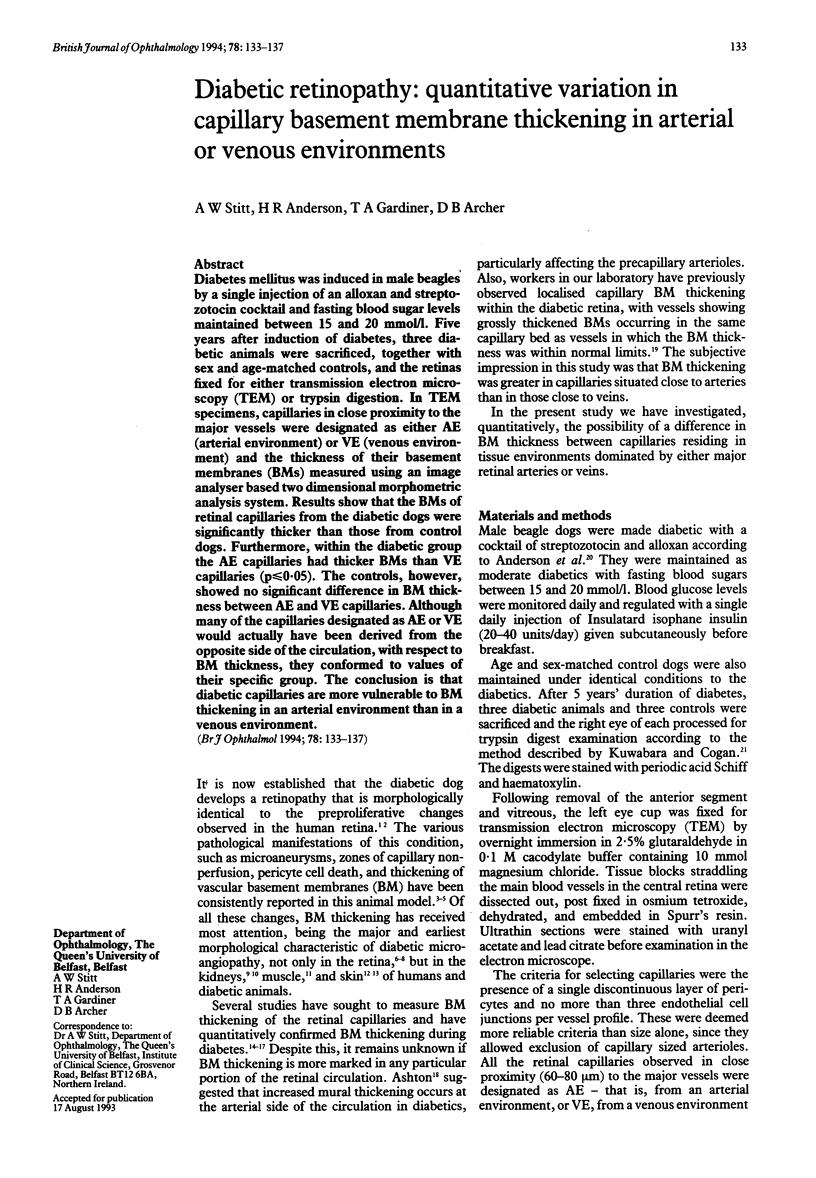
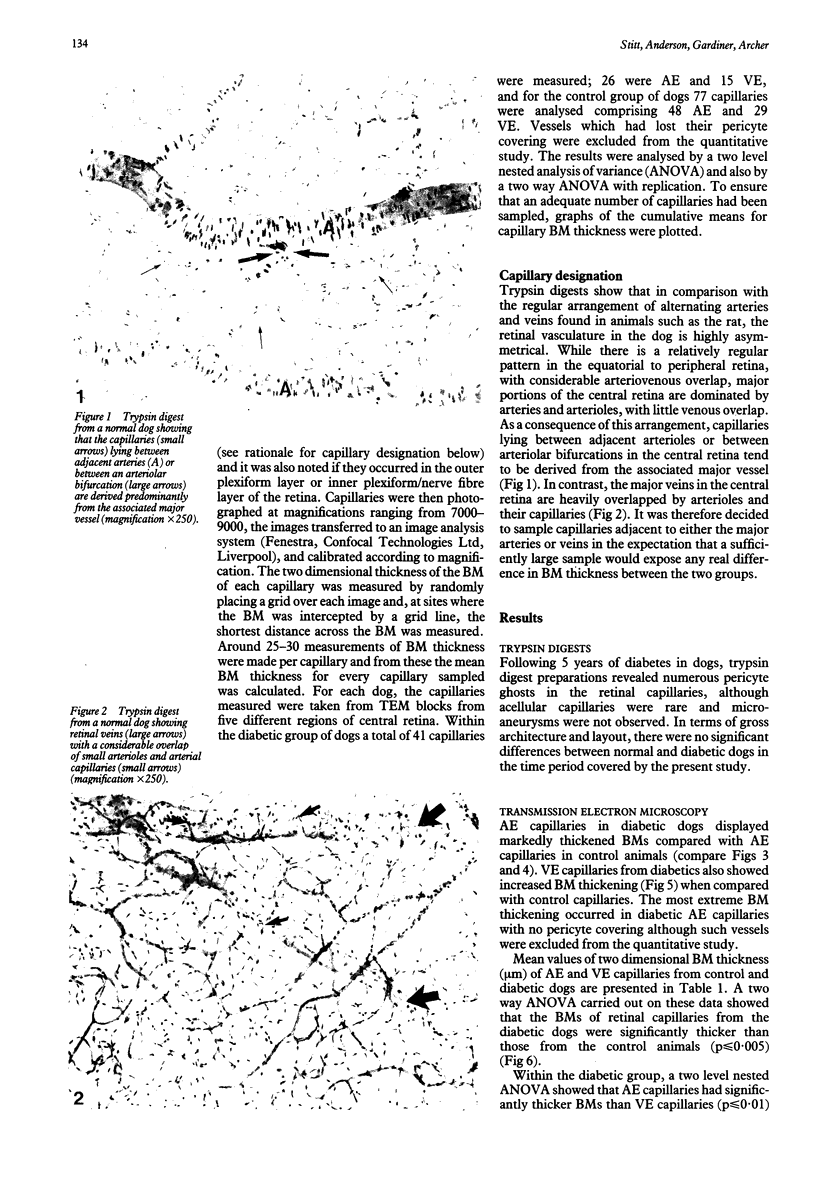
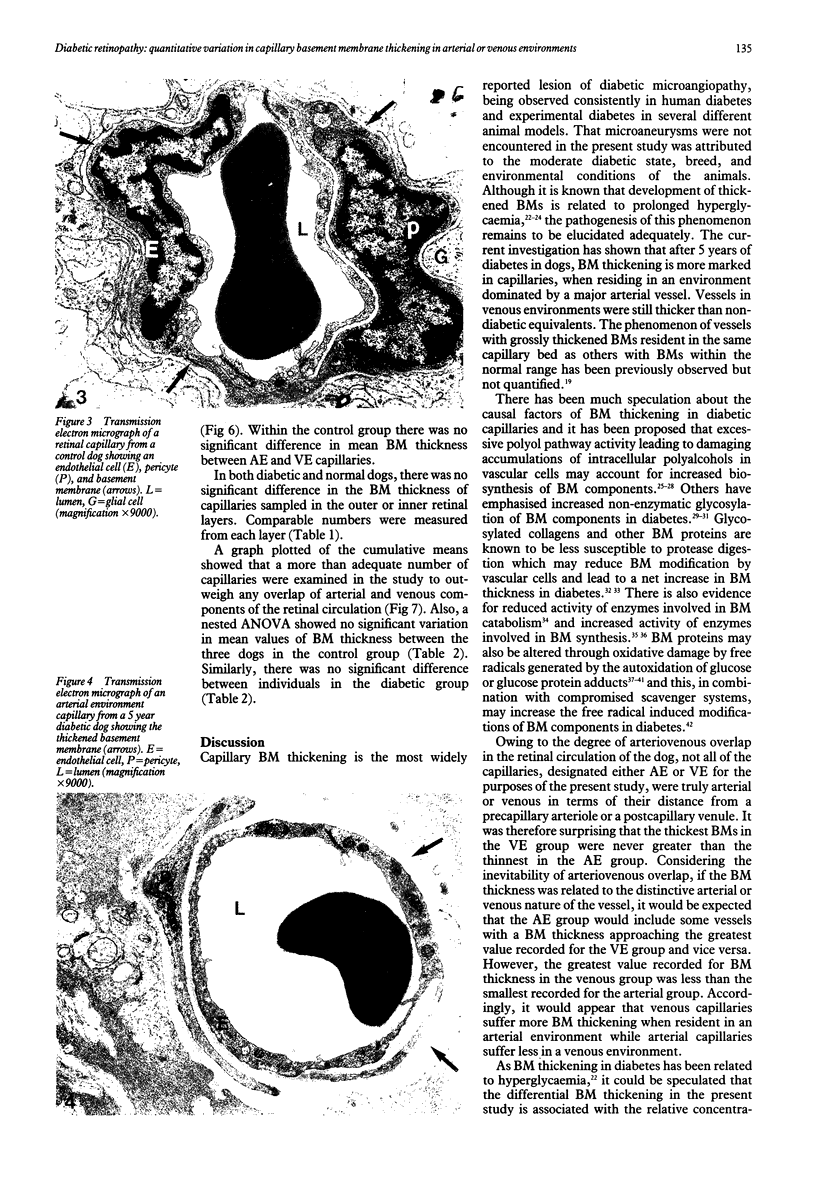
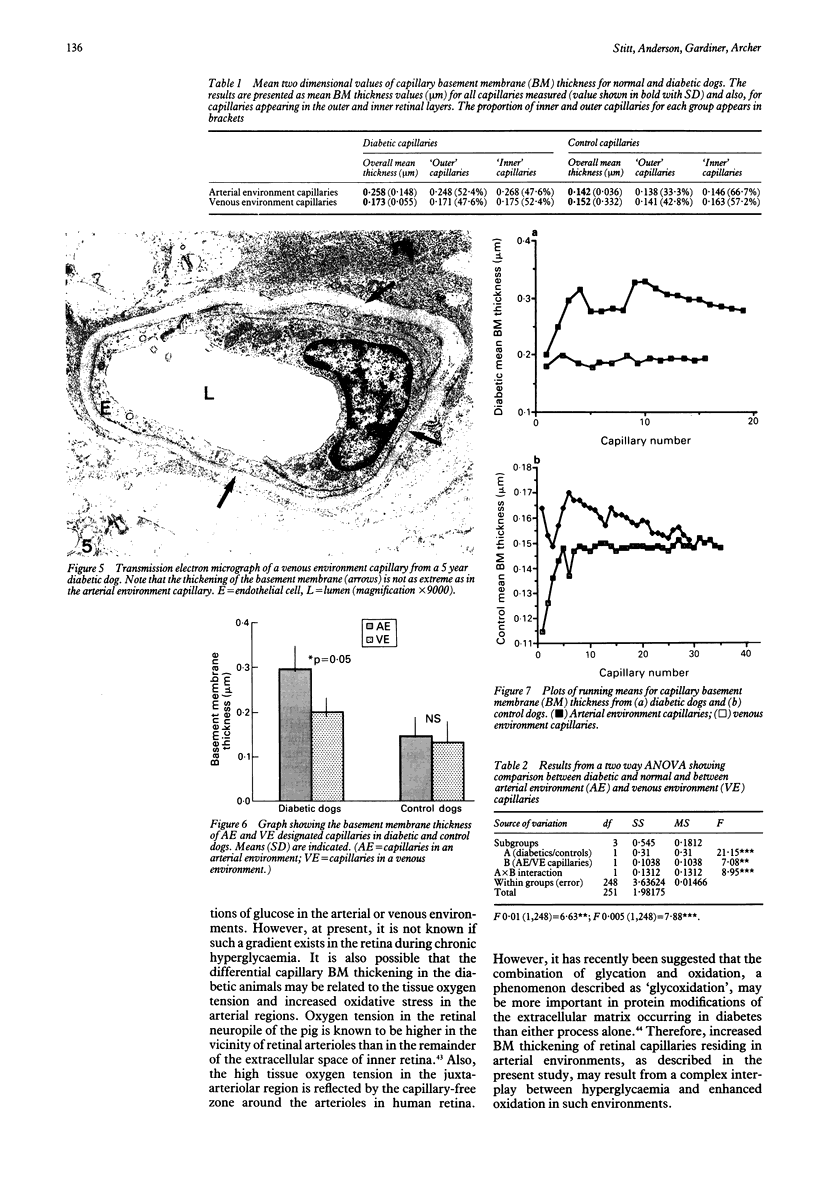
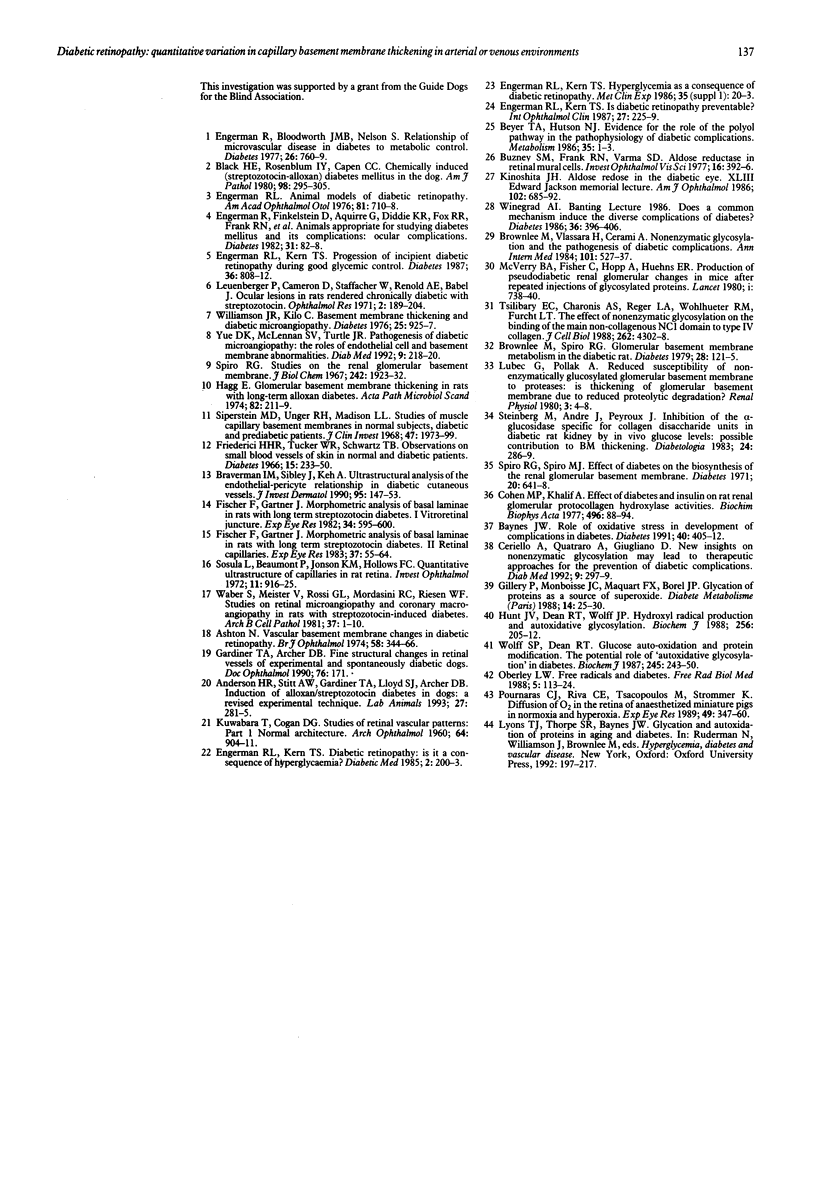
Images in this article
Selected References
These references are in PubMed. This may not be the complete list of references from this article.
- Anderson H. R., Stitt A. W., Gardiner T. A., Lloyd S. J., Archer D. B. Induction of alloxan/streptozotocin diabetes in dogs: a revised experimental technique. Lab Anim. 1993 Jul;27(3):281–285. doi: 10.1258/002367793780745426. [DOI] [PubMed] [Google Scholar]
- Ashton N. Vascular basement membrane changes in diabetic retinopathy. Montgomery lecture, 1973. Br J Ophthalmol. 1974 Apr;58(4):344–366. doi: 10.1136/bjo.58.4.344. [DOI] [PMC free article] [PubMed] [Google Scholar]
- Baynes J. W. Role of oxidative stress in development of complications in diabetes. Diabetes. 1991 Apr;40(4):405–412. doi: 10.2337/diab.40.4.405. [DOI] [PubMed] [Google Scholar]
- Beyer T. A., Hutson N. J. Introduction: evidence for the role of the polyol pathway in the pathophysiology of diabetic complications. Metabolism. 1986 Apr;35(4 Suppl 1):1–3. doi: 10.1016/0026-0495(86)90178-2. [DOI] [PubMed] [Google Scholar]
- Black H. E., Rosenblum I. Y., Capen C. C. Chemically induced (streptozotocin-alloxan) diabetes mellitus in the dog. Biochemical and ultrastructural studies. Am J Pathol. 1980 Feb;98(2):295–310. [PMC free article] [PubMed] [Google Scholar]
- Braverman I. M., Sibley J., Keh A. Ultrastructural analysis of the endothelial-pericyte relationship in diabetic cutaneous vessels. J Invest Dermatol. 1990 Aug;95(2):147–153. doi: 10.1111/1523-1747.ep12477903. [DOI] [PubMed] [Google Scholar]
- Brownlee M., Spiro R. G. Glomerular basement membrane metabolism in the diabetic rat. In vivo studies. Diabetes. 1979 Feb;28(2):121–125. doi: 10.2337/diab.28.2.121. [DOI] [PubMed] [Google Scholar]
- Brownlee M., Vlassara H., Cerami A. Nonenzymatic glycosylation and the pathogenesis of diabetic complications. Ann Intern Med. 1984 Oct;101(4):527–537. doi: 10.7326/0003-4819-101-4-527. [DOI] [PubMed] [Google Scholar]
- Buzney S. M., Frank R. N., Varma S. D., Tanishima T., Gabbay K. H. Aldose reductase in retinal mural cells. Invest Ophthalmol Vis Sci. 1977 May;16(5):392–396. [PubMed] [Google Scholar]
- Ceriello A., Quatraro A., Giugliano D. New insights on non-enzymatic glycosylation may lead to therapeutic approaches for the prevention of diabetic complications. Diabet Med. 1992 Apr;9(3):297–299. doi: 10.1111/j.1464-5491.1992.tb01783.x. [DOI] [PubMed] [Google Scholar]
- Cohen M. P., Khalifa A. Effect of diabetes and insulin on rat renal glomerular protocollagen hydroxylase activities. Biochim Biophys Acta. 1977 Jan 24;496(1):88–94. doi: 10.1016/0304-4165(77)90117-9. [DOI] [PubMed] [Google Scholar]
- Engerman R. L., Kern T. S. Diabetic retinopathy: is it a consequence of hyperglycaemia? Diabet Med. 1985 May;2(3):200–203. doi: 10.1111/j.1464-5491.1985.tb00636.x. [DOI] [PubMed] [Google Scholar]
- Engerman R. L., Kern T. S. Hyperglycemia as a cause of diabetic retinopathy. Metabolism. 1986 Apr;35(4 Suppl 1):20–23. doi: 10.1016/0026-0495(86)90182-4. [DOI] [PubMed] [Google Scholar]
- Engerman R. L., Kern T. S. Is diabetic retinopathy preventable? Int Ophthalmol Clin. 1987 Winter;27(4):225–229. doi: 10.1097/00004397-198702740-00002. [DOI] [PubMed] [Google Scholar]
- Engerman R. L., Kern T. S. Progression of incipient diabetic retinopathy during good glycemic control. Diabetes. 1987 Jul;36(7):808–812. doi: 10.2337/diab.36.7.808. [DOI] [PubMed] [Google Scholar]
- Engerman R., Bloodworth J. M., Jr, Nelson S. Relationship of microvascular disease in diabetes to metabolic control. Diabetes. 1977 Aug;26(8):760–769. doi: 10.2337/diab.26.8.760. [DOI] [PubMed] [Google Scholar]
- Engerman R., Finkelstein D., Aguirre G., Diddie K. R., Fox R. R., Frank R. N., Varma S. D. Ocular complications. Diabetes. 1982;31(Suppl 1 Pt 2):82–88. doi: 10.2337/diab.31.1.s82. [DOI] [PubMed] [Google Scholar]
- Fischer F., Gärtner J. Morphometric analysis of basal laminae in rats with long-term streptozotocin diabetes L. II. Retinal capillaries. Exp Eye Res. 1983 Jul;37(1):55–64. doi: 10.1016/0014-4835(83)90149-5. [DOI] [PubMed] [Google Scholar]
- Fischer F., Gärtner J. Morphometric analysis of basal laminae in rats with long-term streptozotocin diabetes. I. Vitreoretinal juncture. Exp Eye Res. 1982 Apr;34(4):595–600. doi: 10.1016/0014-4835(82)90033-1. [DOI] [PubMed] [Google Scholar]
- Friederici H. H., Tucker W. R., Schwartz T. B. Observations on small blood vessels of skin in the normal and in diabetic patients. Diabetes. 1966 Apr;15(4):233–250. doi: 10.2337/diab.15.4.233. [DOI] [PubMed] [Google Scholar]
- Gillery P., Monboisse J. C., Maquart F. X., Borel J. P. Glycation of proteins as a source of superoxide. Diabete Metab. 1988 Jan-Feb;14(1):25–30. [PubMed] [Google Scholar]
- Hunt J. V., Dean R. T., Wolff S. P. Hydroxyl radical production and autoxidative glycosylation. Glucose autoxidation as the cause of protein damage in the experimental glycation model of diabetes mellitus and ageing. Biochem J. 1988 Nov 15;256(1):205–212. doi: 10.1042/bj2560205. [DOI] [PMC free article] [PubMed] [Google Scholar]
- Hägg E. Glomerular basement membrane thickening in rats with long-term alloxan diabetes. A quantitative electron microscopic study. Acta Pathol Microbiol Scand A. 1974 Mar;82(2):211–219. doi: 10.1111/j.1699-0463.1974.tb03845.x. [DOI] [PubMed] [Google Scholar]
- KUWABARA T., COGAN D. G. Studies of retinal vascular patterns. I. Normal architecture. Arch Ophthalmol. 1960 Dec;64:904–911. doi: 10.1001/archopht.1960.01840010906012. [DOI] [PubMed] [Google Scholar]
- Kinoshita J. H. Aldose reductase in the diabetic eye. XLIII Edward Jackson memorial lecture. Am J Ophthalmol. 1986 Dec 15;102(6):685–692. doi: 10.1016/0002-9394(86)90394-6. [DOI] [PubMed] [Google Scholar]
- Lubec G., Pollak A. Reduced susceptibility of nonenzymatically glucosylated glomerular basement membrane to proteases: is thickening of diabetic glomerular basement membranes due to reduced proteolytic degradation? Ren Physiol. 1980;3(1-6):4–8. doi: 10.1159/000172733. [DOI] [PubMed] [Google Scholar]
- McVerry B. A., Fisher C., Hopp A., Huehns E. R. Production of pseudodiabetic renal glomerular changes in mice after repeated injections of glucosylated proteins. Lancet. 1980 Apr 5;1(8171):738–740. doi: 10.1016/s0140-6736(80)91234-9. [DOI] [PubMed] [Google Scholar]
- Oberley L. W. Free radicals and diabetes. Free Radic Biol Med. 1988;5(2):113–124. doi: 10.1016/0891-5849(88)90036-6. [DOI] [PubMed] [Google Scholar]
- Pournaras C. J., Riva C. E., Tsacopoulos M., Strommer K. Diffusion of O2 in the retina of anesthetized miniature pigs in normoxia and hyperoxia. Exp Eye Res. 1989 Sep;49(3):347–360. doi: 10.1016/0014-4835(89)90045-6. [DOI] [PubMed] [Google Scholar]
- Siperstein M. D., Unger R. H., Madison L. L. Studies of muscle capillary basement membranes in normal subjects, diabetic, and prediabetic patients. J Clin Invest. 1968 Sep;47(9):1973–1999. doi: 10.1172/JCI105886. [DOI] [PMC free article] [PubMed] [Google Scholar]
- Sosula L., Beaumont P., Jonson K. M., Hollows F. C. Quantitative ultrastructure of capillaries in the rat retina. Invest Ophthalmol. 1972 Nov;11(11):916–925. [PubMed] [Google Scholar]
- Spiro R. G., Spiro M. J. Effect of diabetes on the biosynthesis of the renal glomerular basement membrane. Studies on the glucosyltransferase. Diabetes. 1971 Oct;20(10):641–648. doi: 10.2337/diab.20.10.641. [DOI] [PubMed] [Google Scholar]
- Spiro R. G. Studies on the renal glomerular basement membrane. Nature of the carbohydrate units and their attachment to the peptide portion. J Biol Chem. 1967 Apr 25;242(8):1923–1932. [PubMed] [Google Scholar]
- Sternberg M., Andre J., Peyroux J. Inhibition of the alpha-glucosidase specific for collagen disaccharide units in diabetic rat kidney by in vivo glucose levels: possible contribution to basement membrane thickening. Diabetologia. 1983 Apr;24(4):286–289. doi: 10.1007/BF00282715. [DOI] [PubMed] [Google Scholar]
- Tsilibary E. C., Charonis A. S., Reger L. A., Wohlhueter R. M., Furcht L. T. The effect of nonenzymatic glucosylation on the binding of the main noncollagenous NC1 domain to type IV collagen. J Biol Chem. 1988 Mar 25;263(9):4302–4308. [PubMed] [Google Scholar]
- Waber S., Meister V., Rossi G. L., Mordasini R. C., Riesen W. F. Studies on retinal microangiopathy and coronary macroangiopathy in rats with streptozotocin-induced diabetes. Virchows Arch B Cell Pathol Incl Mol Pathol. 1981;37(1):1–10. doi: 10.1007/BF02892551. [DOI] [PubMed] [Google Scholar]
- Williamson J. R., Kilo C. Basement-membrane thickening and diabetic microangiopathy. Diabetes. 1976;25(2 Suppl):925–927. [PubMed] [Google Scholar]
- Winegrad A. I. Banting lecture 1986. Does a common mechanism induce the diverse complications of diabetes? Diabetes. 1987 Mar;36(3):396–406. doi: 10.2337/diab.36.3.396. [DOI] [PubMed] [Google Scholar]
- Wolff S. P., Dean R. T. Glucose autoxidation and protein modification. The potential role of 'autoxidative glycosylation' in diabetes. Biochem J. 1987 Jul 1;245(1):243–250. doi: 10.1042/bj2450243. [DOI] [PMC free article] [PubMed] [Google Scholar]
- Yue D. K., McLennan S. V., Turtle J. R. Pathogenesis of diabetic microangiopathy: the roles of endothelial cell and basement membrane abnormalities. Diabet Med. 1992 Apr;9(3):218–223. doi: 10.1111/j.1464-5491.1992.tb01765.x. [DOI] [PubMed] [Google Scholar]







